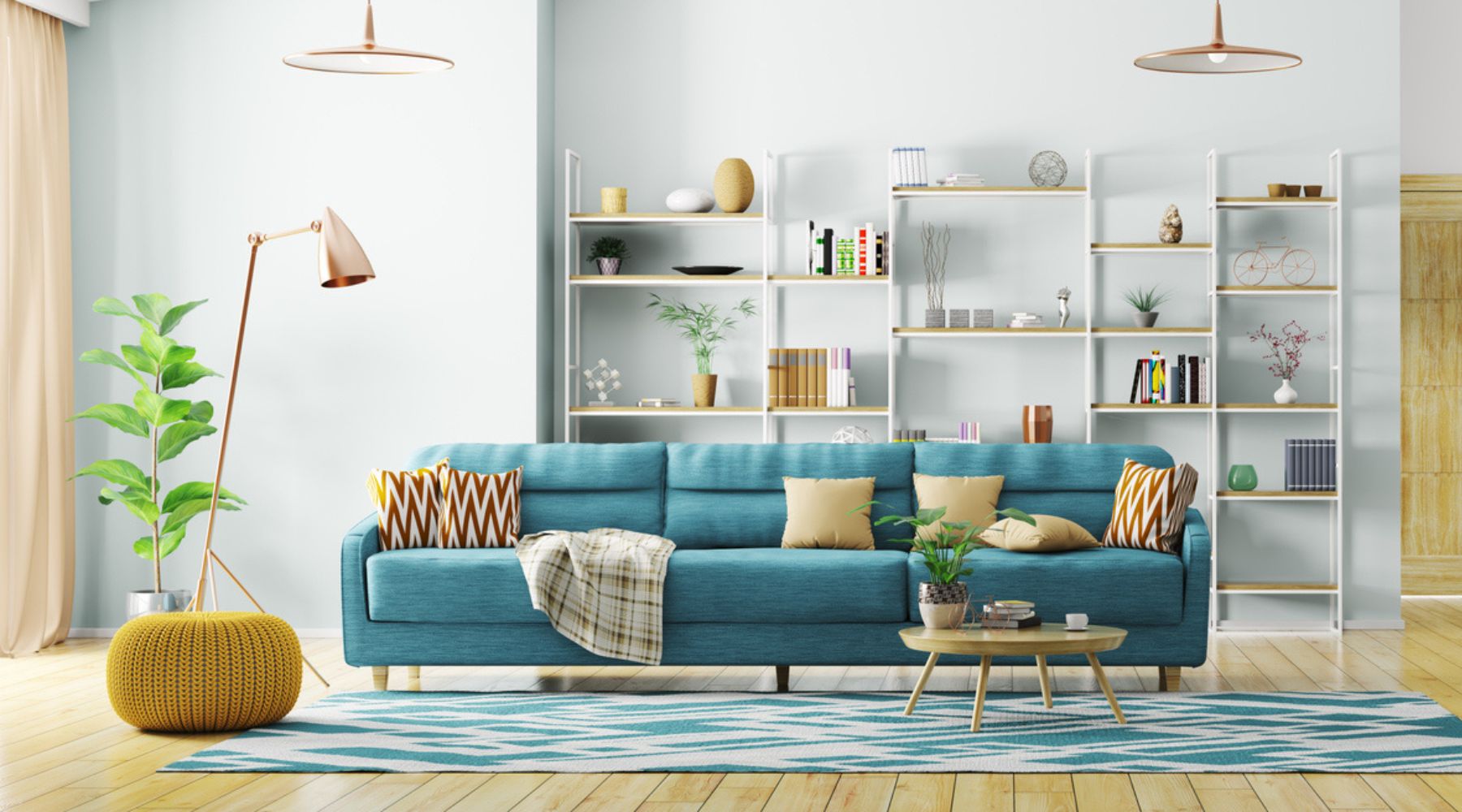
Scandinavian Interior Design: 6 Tips to Bring Scandi Style to Your Home
Scandinavian interior design—whether you’ve seen it in an Ikea catalog, minimalist blogs, or your best friend’s living room, you probably already know how this popular home design style feels. It’s clean, crisp, inviting, calming yet with plenty of interest. But what is Scandi design, really? And how do you bring it into your own space? It’s a style that can be difficult to emulate when you don’t know what’s making it work.
As a movement, Scandinavian design began in the early 20th century, mixing old and new styles from Denmark, Sweden, Iceland, Finland, and Norway. In the 1950s, Scandinavian interior design gained traction in the US and Canada. If you look closely, you can see where Scandi design intersects with mid-century modern design, both of which were heavily influenced by industrialization, and the modernist sensibilities of Germany’s Bauhaus movement.
In Scandinavia, however, industrialization came later than much of Europe, and so Scandinavian design reflects both modern trends and traditional trades, leading to an overall style that blends fresh design with time-honored elements of craftsmanship.
The style was, and continues to be, simple and minimal, functional and accessible, craftsman yet affordable. At its heart, Scandinavian home design centers on simple yet impactful ways of improving daily life, adding design to the ordinary, and bringing it within financial reach.
In this guide, we’ll teach you key Scandinavian design principles to help you understand the meaning behind the look, and offer useful Scandinavian design tips so that you, too, can enjoy the benefits of this beautiful, practical, and calming interior design style. No Scandinavian ancestry required.
1. Minimize
Scandinavian design emphasizes bright, light, and open spaces, with enough room to move and breathe within them. Visual elements like clean lines and white space evoke a sense of calm and capacity. One thing a Scandinavian room is not? Cluttered.
Naturally, the first step for most is decluttering. But rather than going for a stark and ultra-minimalist look, we suggest you aim for lagom, a Swedish term that translates to “in between” or “just right.” We want not too much, and not too little. A similar concept is Japanese organizer Marie Kondo’s “just-right click point.” It’s personal, and you’ll know it when you get there.
If you do need some concrete tips for lagom, use pattern and color sparingly (in rugs and accents, for example), and try balancing any too much-ness with opposite qualities in the room. Then, to hone in on your individual definition of lagom, add or remove items until you feel like you’ve arrived. And don’t forget: shop and add pieces to your rooms with mindfulness. Scandinavian décor on a budget is easier than you think! To learn more about lagom beyond its application to interiors, read this book by design-lover and England-to-Sweden transplant Niki Brantmark.

2. Choose quality
In keeping with the Scandinavian tradition of craftsmanship, invest in high quality, multi-purpose or practical pieces, if you don’t already have them. Scandinavian furniture, light fixtures, and other functional items should have a modern and striking look, while remaining simple and not overly ornate.
Take note: this doesn’t mean sacrificing style. In fact, when ordinary items are made well (and from high quality materials), they can become decorative elements in their own right. Look for the design in the ordinary and storage-as-décor pieces like garment and shoe racks, shelves and organizers, and other storage-included items—all of which can function as helpers in your home and stunning design elements.

3. Bring nature inside
Scandinavians have a unique and hard-earned appreciation for nature because, historically, natural resources in Scandinavian countries were scarce. People had to learn to work with nature, to understand and respect it, in order to get the most out of what nature offered. This appreciation for nature comes through in the way Scandinavians spend time outdoors, and in the way they design and decorate their homes.
You can honor nature as a Scandinavian design principle by incorporating natural elements, such as light and bright wood, nature-inspired sculptural pieces, house plants, and natural textiles and upholstery, such as wool, mohair, sheepskin, linen, jute, burlap, and more. Use plants and natural objects in vignettes. Let in light and views from outside. And whenever you can, use eco-friendly and sustainable materials in your home.
4. Think neutral (with pops of color)
When considering color, imitate the palette of nature—think earth, stone, and wood, with pops of brighter color. A neutral color scheme is simple yet sophisticated, and choosing lighter versions of wall color gives lightness, as does light wood. This backdrop makes it possible for furniture pieces to function as accents, providing interest and contrast. With larger blocks of accent color—and color is allowed—go for grayish blues, green plants, warm tan, neutral (unsaturated) versions of color, monochromatic color stories, and graphic and botanical prints. With smaller accents, bright and bold colors are welcome infusions of joy. For a sense of the livelier accent hues, see the work of famous Finnish design house Marimekko. To learn more about how a white room can come alive, see Scandinavia Standard’s White Room series.

5. Use contrast
As with most interior design styles, Scandinavian room design relies on the design principle of contrast. And while many people typically think of colors at the opposite ends of the color wheel when they hear the word contrast, in this case, contrast can apply to a wide range of design elements (think: shape, size, texture, mood). Instead of contrasting colors, contrast light and dark neutrals, old pieces and new pieces, abstract and natural, straight and wavy, neutral and flashes of color, hard and soft, utility and coziness. To heighten the look, find ways to contrast your foundational pieces, such as walls, furniture, light fixtures, and wall art.

6. Add some hygge
Critics of Scandinavian design often mistake the style for minimalism, which many people consider harsh and cold—maybe the last thing you’d want in a northern climate. Some people do enjoy a version of Scandinavian style that is lean, minimal, and almost monastic. But more often than not, the coolness of white and potentially uninviting clean lines are softened by warmer textures and colors, and another important piece of the puzzle: hygge.
Hygge is a Danish word that roughly translates to cozy togetherness. And since Scandinavian design is informed by the dark and bitterness of Scandinavian winters, staying warm and comfortable is essential.
To increase hygge, add things that remind you of warmth and comfort, such as candles, soft blankets, and slippers. If you have a fireplace, make this a focal point and gathering place. Add personal touches that make you happy.
Hygge is very much about relaxation and ease, so don’t be afraid to keep throw blankets unfolded, covers rumpled, and well-loved items in clear view. And when planning the layout of your rooms, try to create oases of comfort, such as cozy chairs for reading and drinking tea. See our guide to hygge for more on how to bring this Danish concept to your life and home.

Where is Scandinavian design headed?
Nothing is static in the design world. Traditional Scandinavian interior design has evolved over the years, to accommodate changes in culture and tastes, and to reflect interaction with other ways of doing things. Some newer trends fit nicely within the traditional aesthetic, such as the inclusion of worn leather, white paper lantern lights, plank-style floating shelves, monochrome art, black and white stripes, or the fusion of Scandinavian design with other styles such as Japanese and bohemian interior design. And others are forays into new territory, like the entrance of millennial pink, bold color blocks, bright yellows, and much stronger colors in general.
In keeping with what’s old and new in Scandinavian design, The Modern Dane continues to focus on crafting high-quality European linen duvet covers, but with a finger on the pulse of what’s new in Scandi design—and that’s why we’ve embraced bolder colors in our botanical prints, from saturated greens to rich purples (find them at the shop). We look forward to seeing what’s next!








1 comment
Your blog post on “6 Tips to Bring Scandi Style to Your Home” is wonderfully written—clear, practical, and beautifully captures the spirit of the aesthetic: simplicity, comfort, and thoughtful design. Thank you for the inspiration!
Fit Future Group
Leave a comment
This site is protected by hCaptcha and the hCaptcha Privacy Policy and Terms of Service apply.